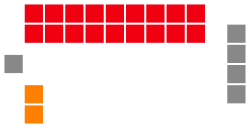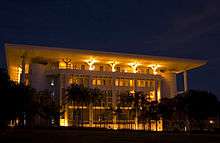Parliament of the Northern Territory
| Northern Territory Parliament | |
|---|---|
| Type | |
| Type | |
| Houses | Legislative Assembly |
| History | |
| Founded | 1974 |
| Leadership | |
| Structure | |
| Seats | 25 |
 | |
Political groups |
Government
Opposition
Crossbench
|
| Meeting place | |
 | |
|
Parliament House, Darwin, Northern Territory, Australia | |
| Website | |
| www.nt.gov.au/lant | |
The Northern Territory Parliament consists of the Northern Territory Legislative Assembly and the Monarch represented by the Administrator of the Northern Territory. It is one of the three territory unicameral parliaments in the country, the upper house, the Legislative Council, was replaced by the Legislative Assembly in 1974. The Legislative Assembly sits in Parliament House in the territory capital, Darwin.
The leader of the party with the most seats in the Legislative Assembly is invited by the Administrator of the Northern Territory to form government. The head of the government is the Chief Minister.
History
From 1911 to 1947 the laws of the Northern Territory were made by the Commonwealth Government.
In 1947 the Northern Territory (Administration) Act was amended to provide for a territory legislature. The first Legislative Council for the Northern Territory was created in Darwin in March 1948. It consisted of seven official members appointed by the Governor-General, six elected members and the Administrator as President of the Council.
In 1974 the Legislative Council was replaced by a fully elected Northern Territory Legislative Assembly with nineteen members.
From 1974 until 2001, the Assembly was controlled by the conservative Country Liberal Party, which is affiliated with the federal Liberal-National coalition. However, at the 2001 election, the Australian Labor Party won government for the first time on a one-seat majority, with Clare Martin becoming the Territory's first Labor and first female Chief Minister. Labor won 19 seats to the CLP's 4 at the 2005 election. Martin resigned in 2007 with Paul Henderson becoming Labor leader, and retained government with another one-seat majority at the 2008 election. The CLP led by Terry Mills defeated Labor at the 2012 election with 16 seats to Labor's 8. Mills resigned in 2013 with Adam Giles becoming CLP leader. The CLP was reduced to a one-seat majority in 2014 when three CLP members defected to the Palmer United Party, however one later rejoined the CLP. After further defections, numbers fell to minority government status in July 2015.[1][2]
The 2016 election saw a landslide CLP defeat which brought Labor to power led by Chief Minister Michael Gunner. The position of Speaker of the Northern Territory Legislative Assembly has been held by CLP-turned-independent MP Kezia Purick since 23 October 2012. Despite Labor's massive majority following the 2016 election, the incoming Labor government re-appointed Purick as Speaker.[3]
See also
- Members of the Northern Territory Legislative Assembly, 2016–2020
- Northern Territory Government
- Northern Territory Legislative Assembly
- Northern Territory Legislative Council
- Parliament House, Darwin
- Parliaments of the Australian states and territories
References
- ↑ Kezia Purick quits Northern Territory Country Liberals party, Government loses one-seat majority: ABC 20 July 2015
- ↑ Adam Giles would 'love to go to an early election' after Kezia Purick resigns Country Liberals party: ABC 20 July 2015
- ↑ NT Labor Government announces female-dominated Cabinet: ABC 11 September 2016